NAME: Jef Palframan. Giulia Chiostrini, and Gunthild Storeck
DATE AND TIME: 20150309
LOCATION:
Chandler Hall 260, Columbia University - New York, NY
SUBJECT: Plaster Casting a Rose
- Conditions:
- Approx. 67°, no air movement, humidity unknown.
- Equipment:
- Paint Brush: Horse hair fibers. No anticipated negative effect on authenticity.
- Mixing Bowls: Plastic. Not early modern. Used to mix the plaster of paris and pour into the clay moldings. No anticipated negative effect on authenticity.
- Stainless Steel Tray: Used to move the clay casings around the lab sue to space limitations. No anticipated negative effect on authenticity.
- Rolling Pin: Used to manipulate modeling clay. No anticipated negative effect on authenticity.
- Linen: Used to roll out modeling clay. No anticipated effect on authenticity.
- Painting Knife: Used to manipulate modeling clay. No anticipated effect on authenticity.
- Battery Powered Wax Pen: Not an early modern instrument. Used primarily out of safety concerns. An ideal instrument would have been a painting knife heated by a candle or other open flame, however the effect on authenticity in this case is minimal.
- Materials:
- Rose: Locally purchased. No anticipated negative effect on authenticity.
- Wheat Oil: [NEED MORE DETAILS ON THIS MATERIAL] No anticipated negative effect on authenticity.
- Modeling Clay: No anticipated negative effect on authenticity.
- Plaster of Paris: Primary material in molds. No anticipated negative effect on authenticity.
- Brick Dust: Secondary material in molds. No anticipated negative effect on authenticity.
- Butter: [NEED MORE DETAILS ON THIS MATERIAL] No anticipated negative effect on authenticity.
- Masking Tape: Not an early modern material. Used to reinforce the clay encasements in lieu of using more modeling clay.
- Beeswax:
- Venice Red:
- Lead/Tin Alloy:
- Discussion on Procedure:
- The primary recipe for this experiment was 155r - Mouler une rose; however during this experiment, which was conducted simultaneously by the whole class, we called upon several other recipes in the manuscript and the expertise of Andrew Lacey, Siân Lewis, and Dr. Smith. All of the plaster casting recipes from the manuscript can be found here. This experiment was conducted in tandem with Gunthild Storeck and her rose is pictured as well.
- We chose a standard white rose to experiment with. The rose was shortened to approximately a third of its initial length and placed in a wax gate. The wax gate and all of the sprues were constructed the week prior out of beeswax and venice red. The wax gate was an elongated pyramid shape. The rose was then cut shorter on the advice of Dr. Smith and reinserted into the wax gate.
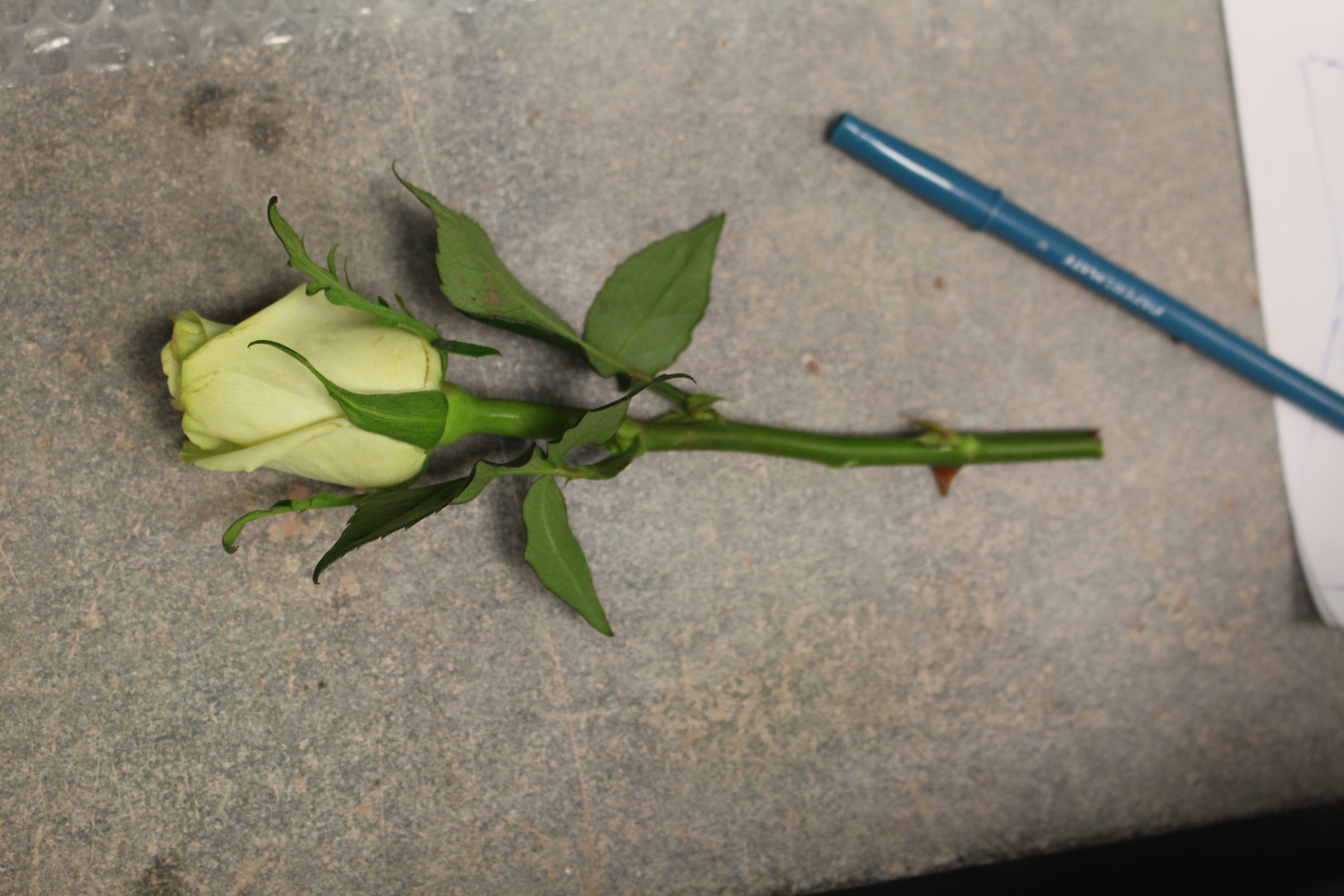 |
| The rose to be molded. Approx ⅔ of the stem were removed, which was deemed to tall. |
- The rose was placed in a molding clay base and depressed approximately one centimeter into the clay. The clay was then pressed flush with the clay base and the clay base was utilized as a base in which to
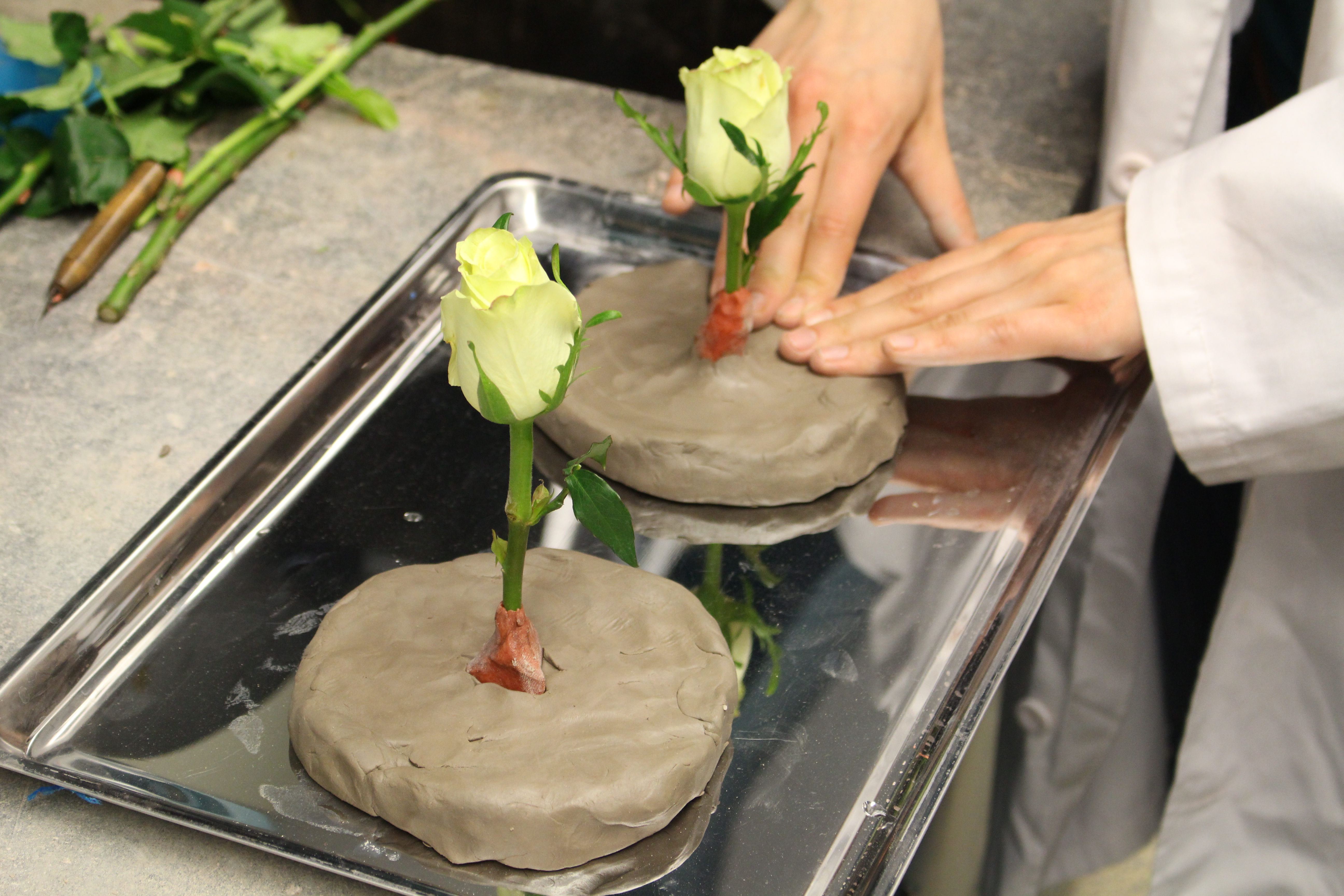 |
| Placing the gated rose in the clay base. |
- As per paragraph p129r_b4, wheat oil was applied to the leaves of the rose in order to stiffen the leaves to withstand the soaked sand.
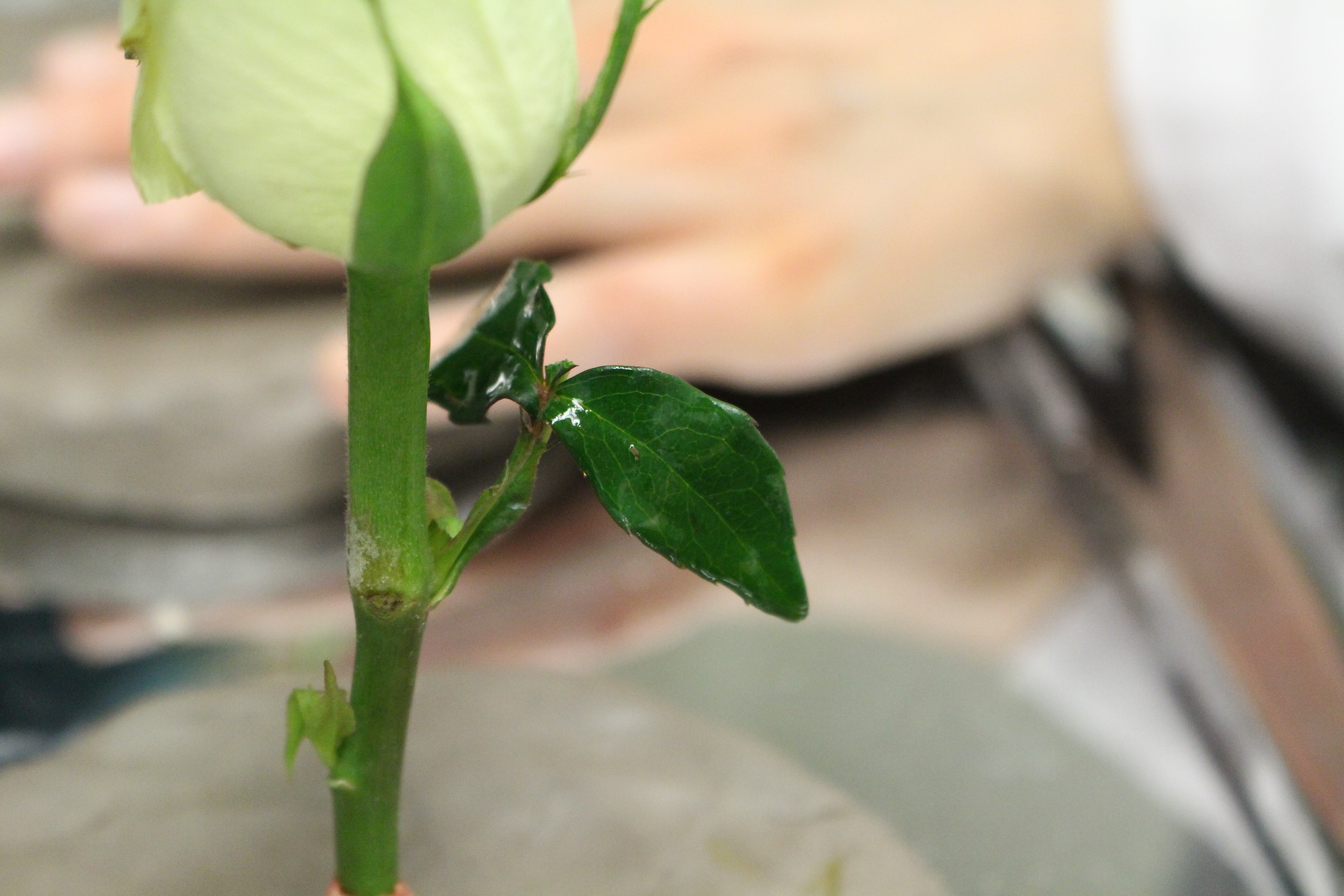 |
| Wheat Oil applied to the leaves of the rose. |
- As per p155r, some melted butter was applied to the outside of the rose petals with a horse hair paint brush in order to “stiffen them and give them the strength to withstand."
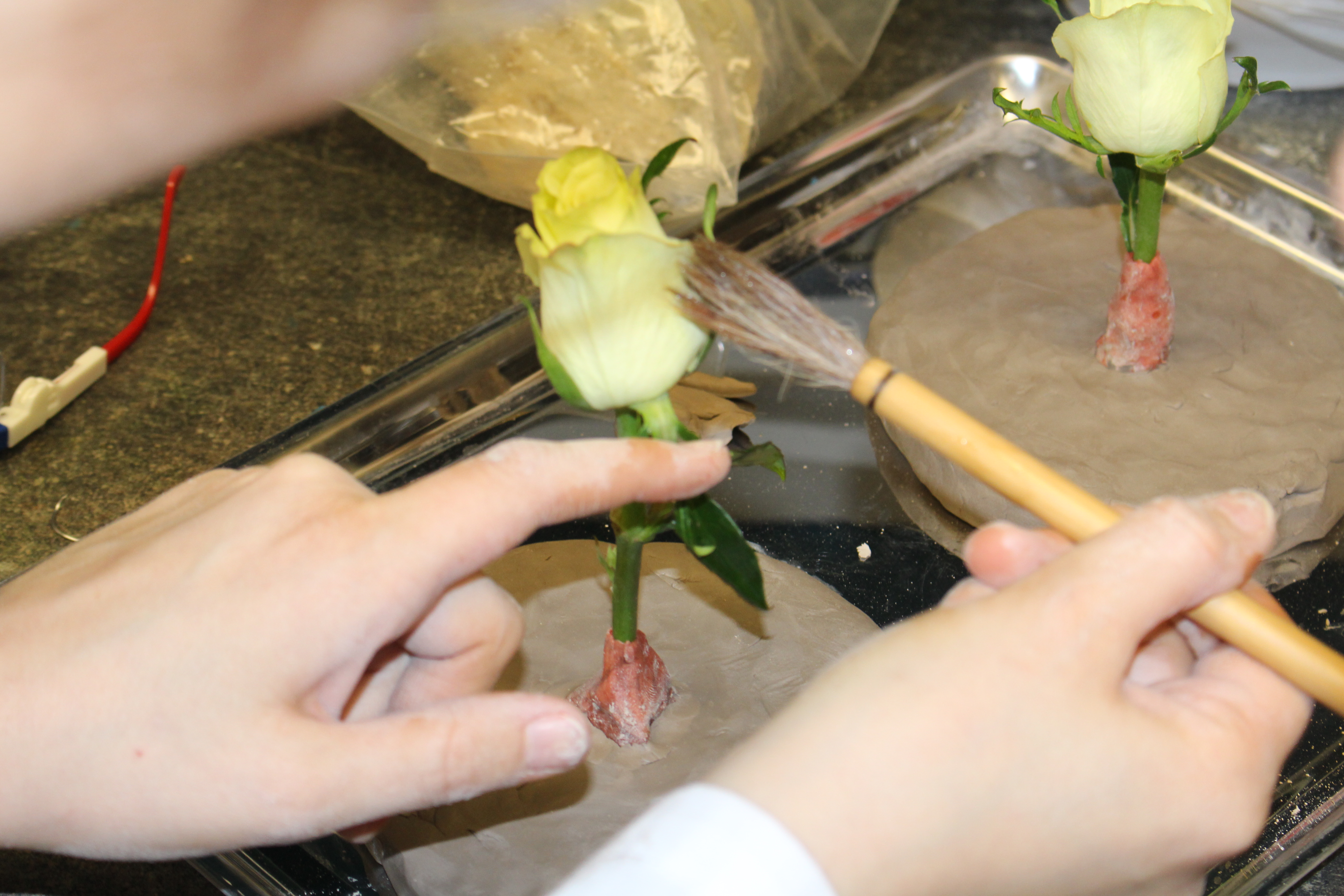 |
| Applying the butter to the outside of the petals. |
 |
| The rose with both wheat oil and butter applied. |
- Once the roses were prepared and dried, the sprue system was put into place. The vents were placed into the clay in the same manner as the main gate. Other individual vents were placed into the clay and attached to the rose with a battery powered wax pen. As per the manuscript and the our experts, the ends of the leaves and petals were connected to the sprue system as much a possible. The participants noticed that making the sprue systems was quite a meditative process and proved quite relaxing. There was a lot of variation in the styles of the systems that emerged among the class.
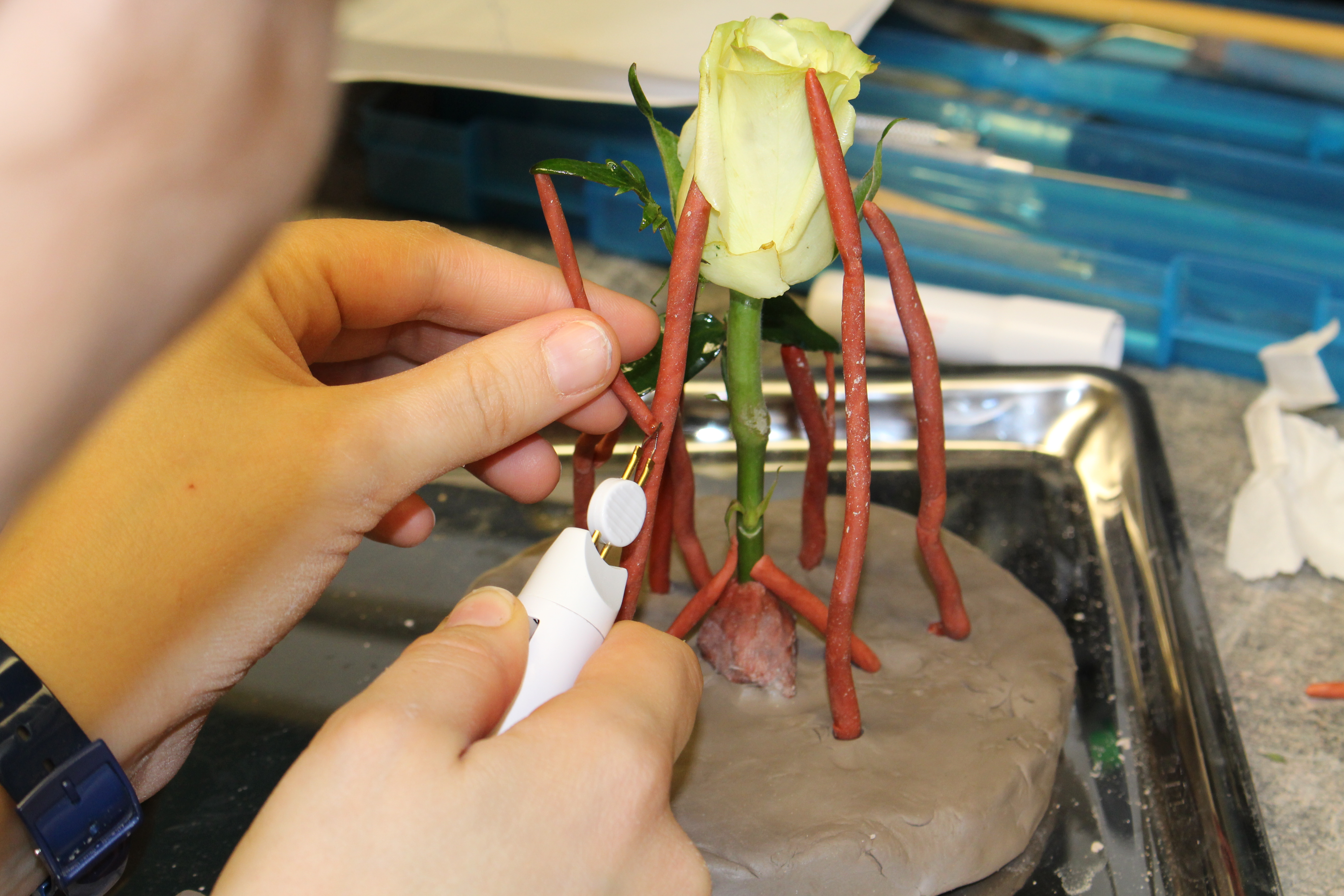 |
| Making the sprue system. |
- The outside wall of the plaster casing was then constructed. As per Siân Lewis, we utilized a piece of linen to roll out the clay walls. The clay was rolled on top of the linen so that it did not stick to the counter when lifted. This technique proved to be a big time saver.
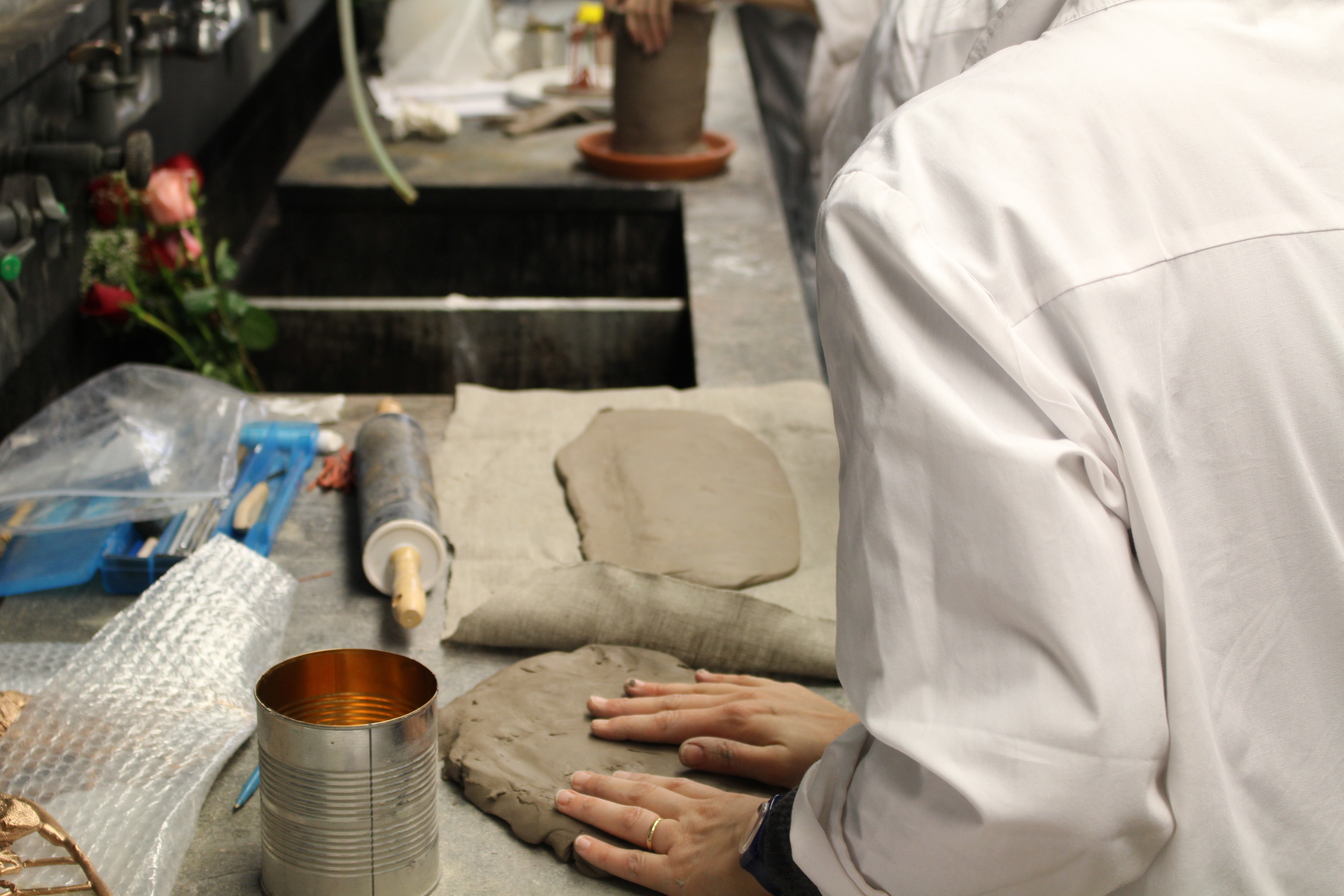 |
| Rolling out the clay on linen. |
- As per the Ms., the walls were made to be bout a finger thick and the sides had two-three inches of clearance.
- The bases of the casting vessels were buttressed with additional modeling clay and the entire vessel was reinforced with masking tape, as per the advice of Andrew Lacey.
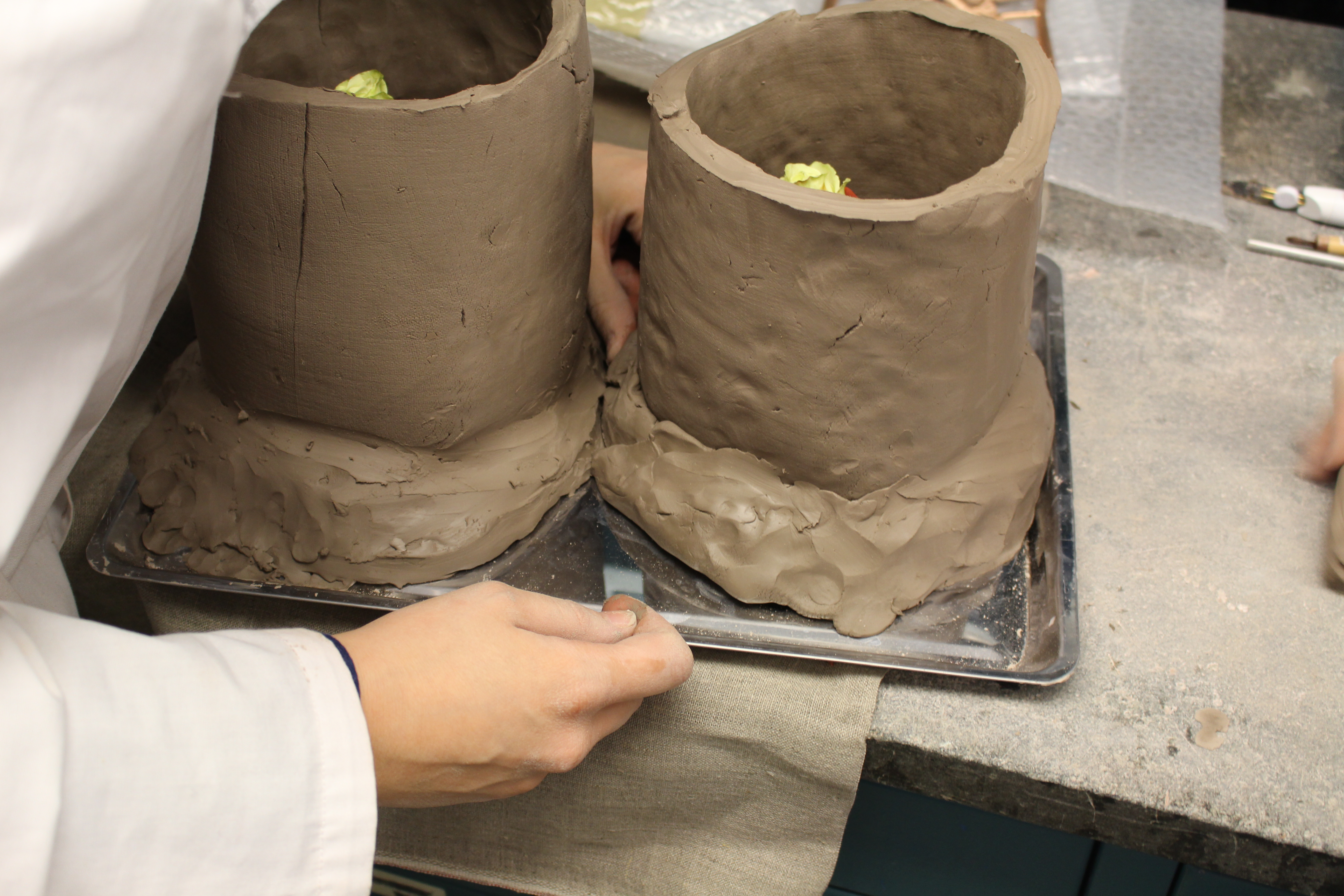 |
| The plaster vessels before the application of the masking tape. |
- Plaster of Paris, brick dust, and water were mixed together [FIND OUT THE EXACT QUANTITIES] and poured into the vessels. Our vessel had to have two pours due to differences in mixing quantities. To combine the layers of plaster we were advised to scratch the top of the first layer to help the plaster layer join together.
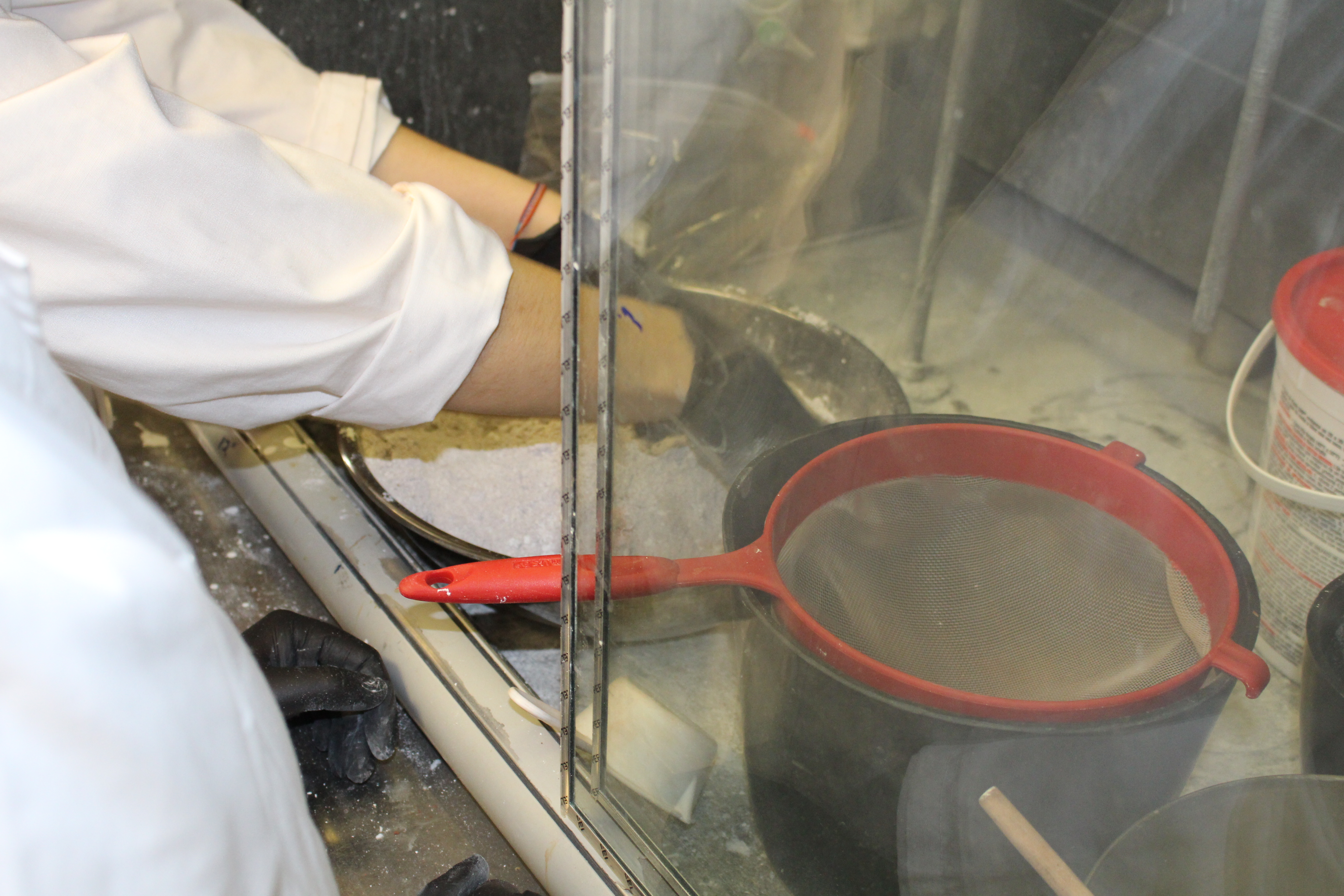 |
| The mixing of the plaster and brick dust. |
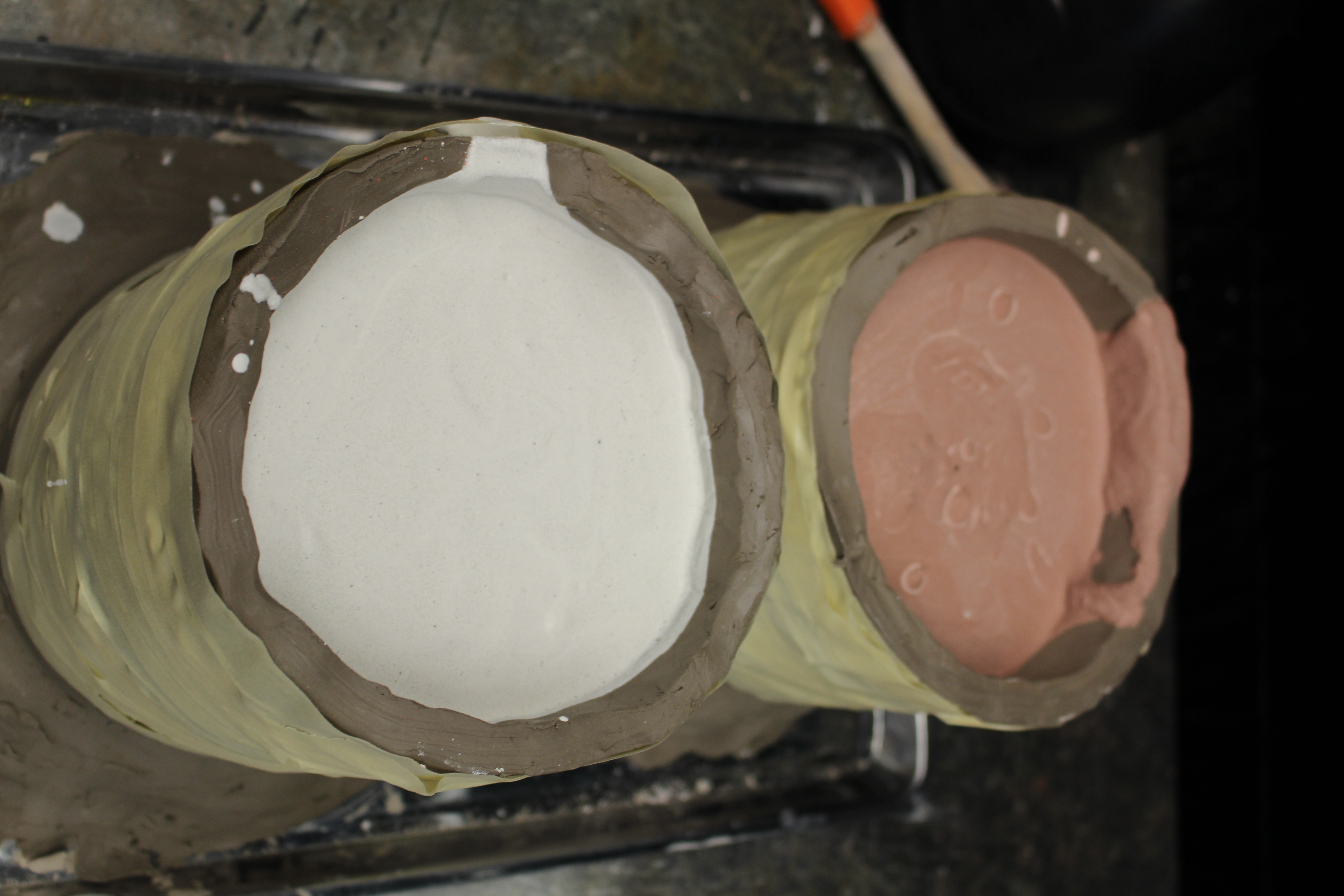 |
| The clay vessel completely filled. |
- The molding clay was removed and the plaster cast was set aside to dry before being placed in the kiln.
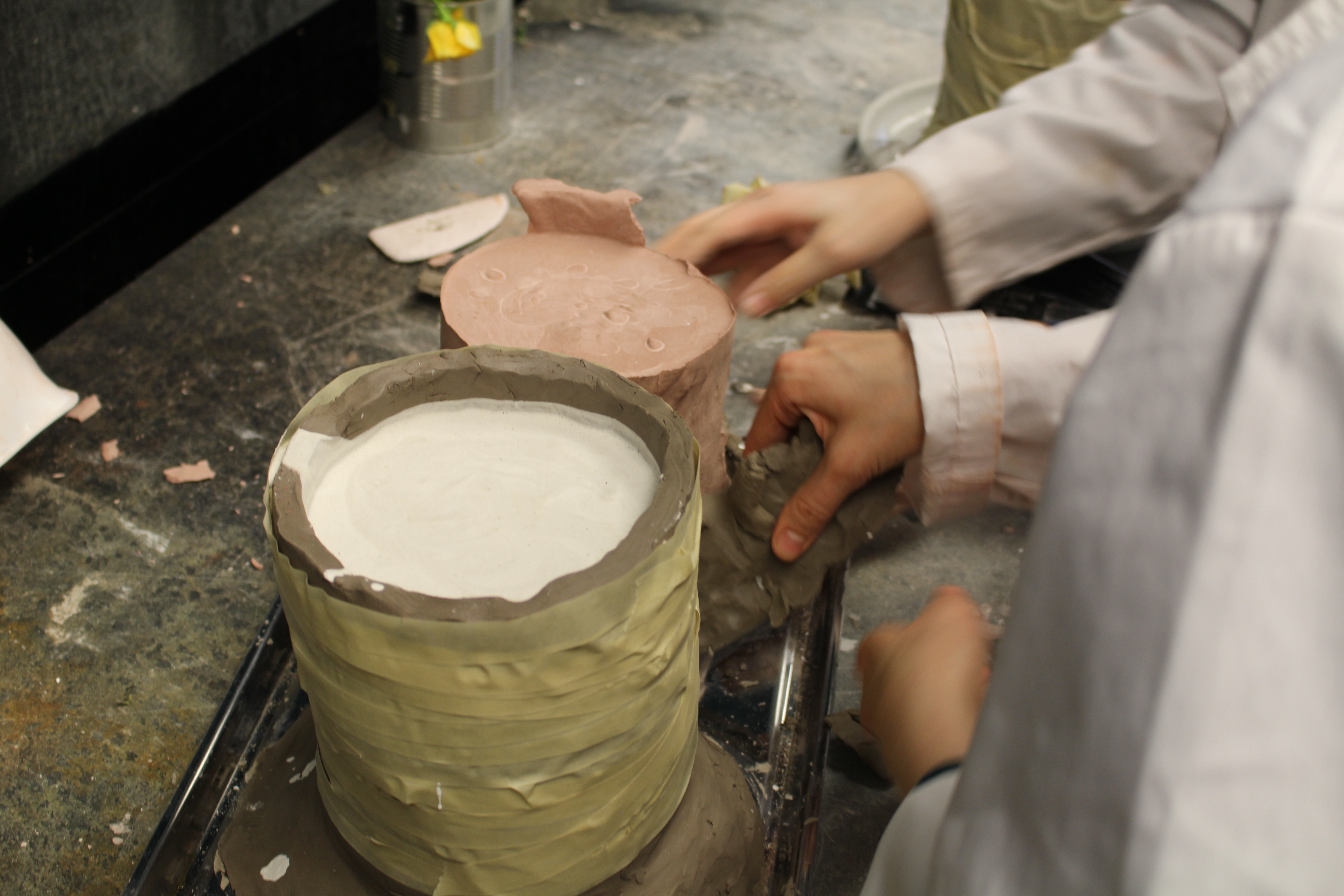 |
| Removing the masking tape and the modeling clay. |
NAME: Jef Palframan. Giulia Chiostrini, and Gunthild Storeck
DATE AND TIME:
LOCATION: Chandler Hall 260, Columbia University - New York, NY
SUBJECT: Plaster Casting a Rose
- Conditions:
- Approx. 67°, no air movement, humidity unknown.
- Equipment:
- Paint Brush: Horse hair fibers. No anticipated negative effect on authenticity.
- Mixing Bowls: Plastic. Not early modern. Used to mix the plaster of paris and pour into the clay moldings. No anticipated negative effect on authenticity.
- Stainless Steel Tray: Used to move the clay casings around the lab sue to space limitations. No anticipated negative effect on authenticity.
- Rolling Pin: Used to manipulate modeling clay. No anticipated negative effect on authenticity.
- Linen: Used to roll out modeling clay. No anticipated effect on authenticity.
- Painting Knife: Used to manipulate modeling clay. No anticipated effect on authenticity.
- Battery Powered Wax Pen: Not an early modern instrument. Used primarily out of safety concerns. An ideal instrument would have been a painting knife heated by a candle or other open flame, however the effect on authenticity in this case is minimal.
- Materials:
- Rose: Locally purchased. No anticipated negative effect on authenticity.
- Wheat Oil: [NEED MORE DETAILS ON THIS MATERIAL] No anticipated negative effect on authenticity.
- Modeling Clay: No anticipated negative effect on authenticity.
- Plaster of Paris: Primary material in molds. No anticipated negative effect on authenticity.
- Brick Dust: Secondary material in molds. No anticipated negative effect on authenticity.
- Butter: [NEED MORE DETAILS ON THIS MATERIAL] No anticipated negative effect on authenticity.
- Masking Tape: Not an early modern material. Used to reinforce the clay encasements in lieu of using more modeling clay.
- Beeswax:
- Venice Red:
- Lead/Tin Alloy:
- Discussion on Procedure: